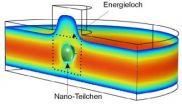(Press-News.org) In order to observe the individual particles in a solution, Prof. Madhavi Krishnan and her co-workers «entice» each particle into an «electrostatic trap». It works like this: between two glass plates the size of a chip, the researchers create thousands of round energy holes. The trick is that these holes have just a weak electrostatic charge. The scientists than add a drop of the solution to the plates, whereupon each particle falls into an energy hole and remains trapped there. But the particles do not remain motionless in their trap. Instead, molecules in the solution collide with them continuously, causing the particles to move in a circular motion. «We measure these movements, and are then able to determine the charge of each individual particle», explains Prof. Madhavi Krishnan.
Put simply, particles with just a small charge make large circular movements in their traps, while those with a high charge move in small circles. This phenomenon can be compared to that of a light-weight ball which, when thrown, travels further than a heavy one. The US physicist Robert A. Millikan used a similar method 100 years ago in his oil drop experiment to determine the velocity of electrically charged oil drops. In 1923, he received the Nobel Prize in physics in recognition of his achievements. «But he examined the drops in a vacuum», Prof. Krishnan explains. «We on the other hand are examining nano particles in a solution which itself influences the properties of the particles».
Electrostatic charge of «nano drugs packages»
For all solutions manufactured industrially, the electrical charge of the nano particles contained therein is also of primary interest, because it is the electrical charge that allows a fluid solution to remain stable and not to develop a lumpy consistency. «With our new method, we get a picture of the entire suspension along with all of the particles contained in it», emphasizes Prof. Madhavi Krishnan. A suspension is a fluid in which miniscule particles or drops are finely distributed, for example in milk, blood, various paints, cosmetics, vaccines and numerous pharmaceuticals. «The charge of the particles plays a major role in this», the Zurich-based scientist tells us.
One example is the manufacture of medicines that have to be administered in precise doses over a longer period using drug-delivery systems. In this context, nano particles act as «packages» that transport the drugs to where they need to take effect. Very often, it is their electrical charge that allows them to pass through tissue and cell membranes in the body unobstructed and so to take effect. «That's why it is so important to be able to measure their charge. So far most of the results obtained have been imprecise», the researcher tells us.
«The new method allows us to even measure in real-time a change in the charge of a single entity», adds Prof. Madhavi Krishnan. «This is particularly exciting for basic research and has never before been possible». This is because changes in charge play a role in all bodily reactions, whether in proteins, large molecules such as the DNA double helix, where genetic make-up is encoded, or cell organelles. «We're examining how material works in the field of millionths of a millimeter».
INFORMATION:
Literature:
Mojarad, N, and Krishnan, M., Measuring the size and charge of single nanoscale
objects in solution using an electrostatic fluidic trap. Nature Nanotechnology (2012)
http://www.nature.com/nnano/journal/vaop/ncurrent/full/nnano.2012.99.html, doi:10.1038/nnano.2012.99
Contact:
Prof. Dr. Madhavi Krishnan
Universität Zürich
Physikalisch-chemisches Institut
Phone: +41 44 635 44 65
e-mail: madhavi.krishnan@ uzh.ch
A giant step in a miniature world: UZH researcher measures the electrical charge of nano particles
2012-07-30
ELSE PRESS RELEASES FROM THIS DATE:
Archaeologists from Bonn discover in Mexico the tomb of a Maya prince
2012-07-30
Archaeologists from the Department of Anthropology of the Americas at the University of Bonn have been excavating for the past four years together with the Mexican National Institute of Anthropology and History in the Maya city of Uxul in Campeche, Mexico. The aim of the excavation project under the direction of Prof. Dr. Nikolai Grube and Dr. Kai Delvendahl is to investigate the process of centralization and collapse of hegemonic state structures in the Maya Lowlands using the example of a mid-sized classic Maya city (Uxul) and its ties to a supra-regional center (Calakmul). ...
Telling the tale of the wealth tail
2012-07-30
A mathematical physicist and her colleague, both from the Free University of Bozen-Bolzano, Italy, are about to publish a study in EPJ B¹ on a family of taxation and wealth redistribution models. The findings could lead to numerical simulations of potential wealth distribution scenarios playing out over the long term and could be used for policy decision making.
Maria Letizia Bertotti and Giovanni Modanese propose a mechanism of individual interaction of economic agents involved in wealth redistribution on a one-to-one level as a means of understanding their collective ...
Brain development is delayed in attention-deficit/hyperactivity disorder
2012-07-30
Philadelphia, PA, July 30, 2012 – Is attention-deficit/hyperactivity disorder (ADHD) due to a delay in brain development or the result of complete deviation from typical development? In the current issue of Biological Psychiatry, Dr. Philip Shaw and colleagues present evidence for delay based on a study by the National Institutes of Health.
The cerebral cortex is the folded gray tissue that makes up the outermost portion of the brain, covering the brain's inner structures. This tissue has left and right hemispheres and is divided into lobes. Each lobe performs specific ...
Archeologists unearth extraordinary human sculpture in Turkey
2012-07-30
A beautiful and colossal human sculpture is one of the latest cultural treasures unearthed by an international team at the Tayinat Archaeological Project (TAP) excavation site in southeastern Turkey. A large semi-circular column base, ornately decorated on one side, was also discovered. Both pieces are from a monumental gate complex that provided access to the upper citadel of Kunulua, capital of the Neo-Hittite Kingdom of Patina (ca. 1000-738 BC).
"These newly discovered Tayinat sculptures are the product of a vibrant local Neo-Hittite sculptural tradition," said Professor ...
In Massachusetts, 'individual mandate' led to decreased hospital productivity
2012-07-30
Philadelphia, Pa. (July 30, 2012) - As the "individual mandate" of the Affordable Care Act moves forward, debate and speculation continue as to whether universal health insurance coverage will lead to significant cost savings for hospitals. The assumption is that providing appropriate primary care will improve the overall health of the population, resulting in less need for hospital services and less severe illness among hospitalized patients. Findings from a recent study published in Health Care Management Review challenge that assumption. Health Care Management Review ...
Long-distance distress signal from periphery of injured nerve cells begins with locally made protein
2012-07-30
PHILADELPHIA (July 30, 2012)— When the longest cells in the body are injured at their farthest reaches, coordinating the cells' repair is no easy task. This is in part because these peripheral nerve cells can be extremely long – up to one meter in adult humans – which is a lot of distance for a molecular distress signal to cover in order to reach the "command center" of the cell's nucleus.
Scientists have believed this process to be even more challenging because their textbook understanding for many years has been that the axons – the long extensions of nerve cells away ...
Obesity in type 2 diabetes: Recommendations from guidelines are largely consistent
2012-07-30
On 10th July 2012, the German Institute for Quality and Efficiency in Health Care (IQWiG) published the results of a literature search for evidence-based guidelines for the treatment of obesity in type 2 diabetes. The aim of the report was to identify those recommendations from current guidelines of high methodological quality that may be relevant for a possible new obesity module in the disease management programme (DMP) for type 2 diabetes.
Diet, exercise and behavioural therapy generally advised
IQWiG found that the recommendations of the various guidelines for the ...
Health coaches could be key to successful weight loss, study suggests
2012-07-30
(PROVIDENCE, R.I.) – Coaches can help athletes score touchdowns and perfect their golf swing, but can they also influence weight loss? Researchers from The Miriam Hospital's Weight Control and Diabetes Research Center say health coaches could play an important role in the battle of the bulge, according to the findings of a pilot study published online in the journal Obesity.
In the first study of its kind, obese individuals participating in a low-intensity behavioral weight loss program who were supported by either a professional health coach or a peer coach lost clinically ...
Pollution can make citizens – both rich and poor – go green
2012-07-30
Nothing inspires environmentalism quite like a smog-filled sky or a contaminated river, according to a new study that also indicates that environmentalism isn't just for the prosperous.
People living in China's cities who say they've been exposed to environmental harm are more likely to begreen: re-using their plastic grocery bags or recycling. Moreover, the study, published this week in the international journal AMBIO, indicates that the poor would sacrifice economic gain to protect their environment.
"The human and natural worlds are tightly coupled and we cannot ...
Health care savings, naturally
2012-07-30
For millions of people around the world being sick doesn't mean making a trip to the local pharmacy for medicines like Advil and Nyquil. Instead it means turning to the forest to provide a pharmacopeia of medicines to treat everything from tooth aches to chest pains.
But while questions persist about whether such natural remedies are as effective as their pharmacological cousins, one Harvard researcher is examining the phenomenon from a unique perspective, and trying to understand the economic benefits people receive by relying on such traditional cures.
As reported ...


